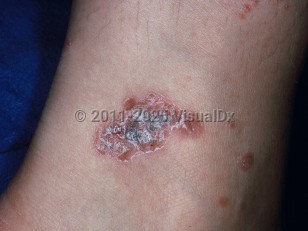Tattoo reaction
Alerts and Notices
Important News & Links
Synopsis

Tattoos are increasingly popular. It is estimated that 24% of individuals in the United States between the ages of 18 and 50 years have a tattoo. It is difficult to assess the prevalence of tattoo reactions because such reactions are often underreported, but symptoms such as persistent itching and intermittent edema may occur in up to 6% of those with tattoos. Granulomatous reactions are more common in women than in men and occur more often with colored tattoos. Adverse reactions are more common on the extremities and head.
Complications that have been attributed to tattoos include acute inflammatory, hypersensitivity, granulomatous, lichenoid, and pseudolymphomatous reactions. Other complications include infections and tumors.
Tattoo inks can be composed of many chemicals or admixtures of chemicals that are not regulated by the US Food and Drug Administration (FDA). Some of these pigments include metallic elements that have been linked to allergic reactions. Mercuric sulfide (cinnabar) used in red pigments has been historically linked to many adverse reactions associated with tattoos and has largely been replaced by other pigments. Many colored pigments are azo pigments, created for the commercial coloring of consumer goods, and have no safety data for their short- or long-term introduction into tissues. Pigments may break down with time or with sun exposure and collect in lymph nodes, which exposes the immune system to exogenous chemicals. Although black pigments are generally associated with fewer adverse reactions, complications may still occur. Black pigment is often made from soot and can contain many toxic or mutagenic compounds such as polycyclic aromatic hydrocarbons. Cadmium used in yellow pigment can cause photo-aggravated toxic reactions. Cobalt found in blue pigments can cause contact hypersensitivity.
Hypersensitivity and granulomatous reactions may occur shortly after receiving a tattoo, within days, or may be delayed until several years after tattoo application. Reactions can be associated with re-tattooing.
Related topics: allergic contact dermatitis, foreign body granuloma
Complications that have been attributed to tattoos include acute inflammatory, hypersensitivity, granulomatous, lichenoid, and pseudolymphomatous reactions. Other complications include infections and tumors.
Tattoo inks can be composed of many chemicals or admixtures of chemicals that are not regulated by the US Food and Drug Administration (FDA). Some of these pigments include metallic elements that have been linked to allergic reactions. Mercuric sulfide (cinnabar) used in red pigments has been historically linked to many adverse reactions associated with tattoos and has largely been replaced by other pigments. Many colored pigments are azo pigments, created for the commercial coloring of consumer goods, and have no safety data for their short- or long-term introduction into tissues. Pigments may break down with time or with sun exposure and collect in lymph nodes, which exposes the immune system to exogenous chemicals. Although black pigments are generally associated with fewer adverse reactions, complications may still occur. Black pigment is often made from soot and can contain many toxic or mutagenic compounds such as polycyclic aromatic hydrocarbons. Cadmium used in yellow pigment can cause photo-aggravated toxic reactions. Cobalt found in blue pigments can cause contact hypersensitivity.
Hypersensitivity and granulomatous reactions may occur shortly after receiving a tattoo, within days, or may be delayed until several years after tattoo application. Reactions can be associated with re-tattooing.
Related topics: allergic contact dermatitis, foreign body granuloma
Codes
ICD10CM:
T78.40XA – Allergy, unspecified, initial encounter
SNOMEDCT:
444004001 – Disorder of skin caused by tattoo ink
T78.40XA – Allergy, unspecified, initial encounter
SNOMEDCT:
444004001 – Disorder of skin caused by tattoo ink
Look For
Subscription Required
Diagnostic Pearls
Subscription Required
Differential Diagnosis & Pitfalls

To perform a comparison, select diagnoses from the classic differential
Subscription Required
Best Tests
Subscription Required
Management Pearls
Subscription Required
Therapy
Subscription Required
References
Subscription Required
Last Updated:06/16/2024

